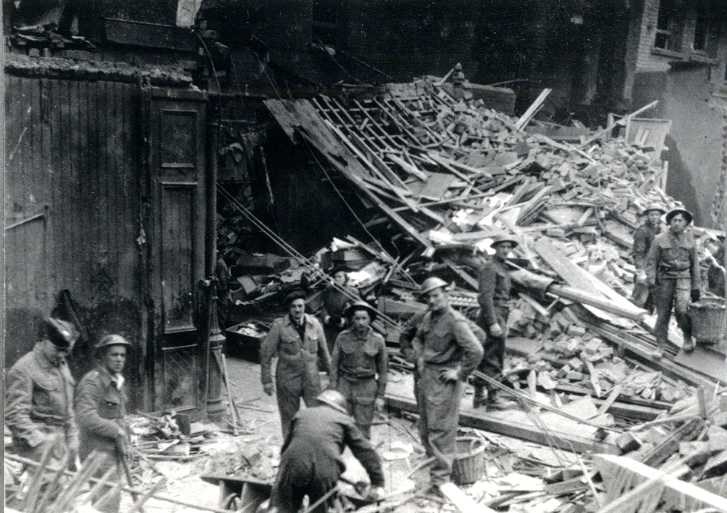
Reading remembers the People’s Pantry bombing 80 years on
- Mayor of Reading, Cllr Rachel Eden, will lead a short service and lay a wreath to pay tribute the people who lost their lives, on Friday 10 February
- Berkshire Record Office has digitised original records from the day, Reading Libraries are hosting an exhibition of documents and photographs on the aftermath of the bombing raid
READING comes together next week to mark the 80th anniversary of the People’s Pantry Bombing, where 41 people lost their lives and many more were injured during World War II.
On Friday 10 February, the Mayor of Reading, Cllr Rachel Eden, will lead a short service and lay a wreath to pay tribute the people who lost their lives when a lone German Dornier bomber dropped four 500kg bombs in the centre of town on 10 February 1943.
Tragically, only 37 of those among the dead and injured were identified, the youngest being two 10-year-old children.
Next week’s service will take place beside in the commemorative plaque on Town Hall Square, near the offices of Blandy and Blandy Solicitors, from 2pm, with members of the public welcome to join.
The plaque was unveiled in 2013, as part of as part of the 70th Anniversary commemorations of the bombing in which 150 people were also injured. Blandy’s chambers were badly damaged by the fourth bomb dropped during the raid. Shrapnel marks are still visible on the adjacent St Laurence’s Church.
Twenty-nine of those killed in the bombing had been inside The People’s Pantry, just opposite the Town Hall, which had been set up as an emergency feeding centre offering cheap meals to help supplement rationed food. A bomb passed through the roof of the building and detonated close to the Town Hall. The raid was one of around 20 air attacks to hit Reading during the war.
The People's Pantry, Friar Street, Reading, 1943, showing the bomb damage from 10 February. A number of men sift through the rubble. Image from Reading Libraries collection.
Paddington Bear author, Michael Bond, was installing a radio transmitter on top of the People’s Pantry at the time.
Nick Burrows, chairman and partner at law firm Blandy & Blandy, said:
“10 February 1943 is unquestionably one of the most difficult days in our firm’s near 300-year history. A member of staff, Mr Frank Seymour, was sadly killed and another injured, and our offices at 1 Friar Street were very badly damaged.
“We are grateful to Reading Borough Council and all involved for organising today’s ceremony to mark this important date. We have made a donation to our two adopted charities, BIBS and the Royal Berks Charity, in recognition of the support that the Royal Berks Hospital provided to those affected at the time.”
Mayor of Reading, Cllr Rachel Eden, said:
“It’s important to come together and mark the anniversary of this tragic day for Reading in which many residents sadly lost their lives or were badly injured.
“Even now there are many local people who remember that dreadful day, and I’d like to welcome them, and the families of those who were affected to join us in paying our respects.”
To mark the anniversary of the raids, the Berkshire Record Office has digitised original records from the day as well as many other archives from the home front. These are available from today via Ancestry (see notes).
Reports and photographs from the raid feature in the papers of William Seager, Reading’s Chief ARP warden. For family historians, there are attendance registers for the London schools evacuated to rural Berkshire during the Blitz. Also online are details of the county’s air raid shelters and plans for the evacuation scheme, as well as papers from various local units of the Home Guard.
You can read some of the eye-witness accounts of the day at Air Raids in Berkshire – Through Their Eyes: www.throughtheireyesww2.com/arp/.
Reading Libraries will host an exhibition of documents and photographs on the aftermath of the bombing raid from their collection as part of the 80th anniversary. It will be available for free viewing on the ground floor of Reading Central Library from 6 February.
ENDS
Notes to editors
Notes:
The four bombs fell in a line from the north bank of the Kennet to just outside the Town Hall.
The first bomb hit Simmonds Brewery and exploded leaving a 25 ft crater near a paint store. The second passed through the offices of the Labour Party on the south side of Minster Street before exploding in the restaurant of Welsteeds department store across the road.
Falling a few moments later the aircraft’s third bomb collapsed part of the Victorian arcade linking Broad St and Friar St before exploding in a yard outside the People’s Pantry in Friar St, one of the town’s ‘British Restaurants’ set up as Emergency Feeding Centres and to offer cheap meals to help supplement rationed food.
The final bomb passed through the top of the People’s Pantry building and detonated a few feet from the south tower of the town hall, bringing down the front of Blandy and Blandy’s solicitors, damaging St Laurence’s Church and severely damaging the Town Hall itself, which was the control centre for Civil Defence in the town.
As the bomber flew off the crew machine gunned the town, injuring a woman in Hemdean Road, Caversham and damaging a school.
After Reading, Newbury was hit. 15 people were killed, and St John’s church destroyed. Unlike in Reading, there was no air raid warning.
Ancestry collections links (paywall) are:
Berkshire, England, World War II Civil Defence Records, 1939-1945 https://www.ancestry.co.uk/search/collections/62464/
Berkshire, England, World War II Evacuation Records, 1939-1945 https://www.ancestry.co.uk/search/collections/62503/
Berkshire, England, World War II Home Guard Records, 1943-1958 https://www.ancestry.co.uk/search/collections/62504/
Berkshire, England, World War II Related Miscellaneous Records, 1939-1971 https://www.ancestry.co.uk/search/collections/62505/

